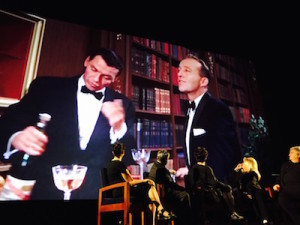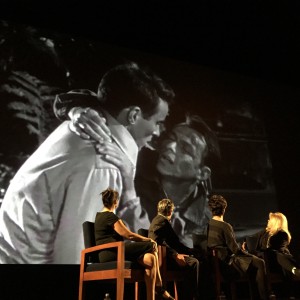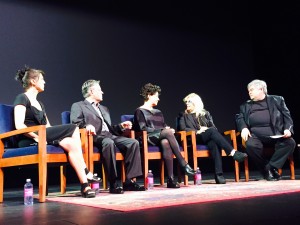The Wallis Celebrates Frank Sinatra Centennial With Screenings and Family Panel
The Wallis Annenberg Center for the Performing Arts Film Series celebrated Frank Sinatra’s 100th Birthday and Hollywood connection with a special afternoon of three screenings and a panel discussion. Mr. Sinatra probably would rather have had a drink and a laugh in the lounge room instead.
I say this also from experience. When I met Frank Sinatra at a friend’s restaurant years ago (Sofi), his daughter had planned a party for him, complete with strict rules regarding where restaurant guests were restricted even before he arrived. Well, Mr. Sinatra arrived with a couple of pals before the party and introduced himself to a few of the restaurant customers – and proved to be an absolute delight. He even serenaded Sofi afterward from the patio and laughed his head off when she mistakenly thought it was one of her wait staff! At the time I admired him, later realizing his iconic talent and was even happier that I met him. If possible, I appreciate it all even more.
The audience was friendly expectant, just having seen the screening of On the Town. On the panel: Lambert, granddaughter of Sinatra and a film and television music consultant; Tina Sinatra, actress-writer- producer daughter; Nancy Sinatra, singer-daughter; and Charles Pignone, author of the definitive new book Sinatra 100, and Senior Vice President of Frank Sinatra Enterprises. Pignone has been associated with the Sinatra Family for three decades. Scenes from the Screenings, including On the Town, From Here to Eternity and Ocean’s 11, were projected on the wall behind the panelists. .
Frank Sinatra’s wide range as an actor in over 60 films was as extraordinary as his singing career as an idol, earning him the nickname, “One Take Charlie,” for his spontaneous, instinctive acting style Tina and Nancy both agreed that he was not a “method actor” by any means.” And they also wondered aloud if their dad never did “didn’t do a major analysis of his lines because if he failed it would look worse than if he just appeared as if he was instinctively winging it.‘
Pignone surmised, “he was an actor who sang some of the same songs he was associage with over and over again. So he could always do 30 to 40 takes if need be.”
“At the same time, he was a self-educated man, an autodidact, a voracious reader on a number of subjects and not unhappy about it,” reported Tina. “He worked on his lines, he hit his mark and he did the job.” When he filmed High Society with fellow singing legend, Bing Crosby,” he was already relaxed because the movie was (essentially) the filming of a party with friends.

Pignone laughed at this, noting that “Bing has written to the producers that Frank ‘wasn’t right for the part.’” The audience roared when Nancy piped up in surprise – “what a —“

It was right in character with the family candidness. Explained Tina, “And we learned early on with our father that ‘he wore his heart on his sleeve.’ If he was joyous, he was filled with joy, if he was sad or morose if someone died close to him, we knew when to be there and when to not be there, to back off. This was also what made his songs so very real.”
Sinatra made three films with Gene Kelly – Anchors Aweigh (1945), Take Me Out to the Ball Game (1949) and On the Town (1949) that became classic MGM musicals. On the Town, co-directed by Kelly and Stanley Donen, became Donen’s first directorial credit, and marked the first time a major studio filmed its musical numbers on location (in New York). It has earned a ranking by the American Film Institute as one of the top twenty musicals, and is easily identifiable by one of the opening numbers, “New York, New York” near the Statue of Liberty.
Filming outdoors was not as easy to set up as indoors. After hours of setting up that proved to not be right, Frank is said to have looked at Donen and said, “I’m taking a break. I’ll be at Toots Shors when you need me!”
Charles Pignone wrote in his book Sinatra 100, “Never one to give up on himself, Sinatra had his sights set on a new project, a role in a movie that he was born to play. The day I heard that a movie was to be made from the bestseller From Here To Eternity I knew, suddenly, that I had something to fight for. I went to [producer] Buddy Adler and I said, ‘Buddy, I’ve never asked you for anything before, but I’m ready to beg for that part. Give it to me and you’ll never be sorry.’ I had read the book and I knew one hundred Maggios in my lifetime. I made a test for Harry Cohn [President of Columbia Pictures]; it was of the drunk scene in the bar. After that I went to Africa to see Ava [Gardner]. I heard that Eli Wallach was testing for it [Maggio] and I thought I’d never get the part. I had to come back to make the picture. I would have done it for nothing.”

In April 1953 Sinatra signed a contract with Capitol Records and four months later, From Here to Eternity was released to huge critical and public acclaim, starring Burt Lancaster, Montgomery Clift, Deborah Kerr, Sinatra, and Donna Reed, and directed by Fred Zinnemann. In the scheme of things it does not mean much, but it a universal gift to me. The evening I returned home from the Wallis Panel and turned on the TV, there was From Here to Eternity starting.
On March 25, 1954 the film won eight Academy Awards including Best Picture, Director, and Screenplay. Sinatra won the Oscar for his portrayal of Private Angelo Maggio. That evening, one of the greatest in Sinatra’s professional life, also marked one of the most dramatic and greatest comebacks in the history of show business. From Here to Eternity, South of the Border, and Young at Heart were huge hits on the radio and in albums at the time.
Sinatra remained back on top with accolades for film roles in Young at Heart, The Tender Trap, The Man With the Golden Arm, Guys and Dolls, High Society, Pal Joey, and A Hole in the Head. In 1960 – with the albums Come Dance With Me and Nice ‘n’ Easy at the top of the charts at the same time.
Ocean’s 11 was released in 1960. Directed by Lewis Milestone, It stars Sinatra, Dean Martin, Sammy Davis Jr., Peter Lawford, and Angie Dickinson. Movie audiences appreciated the intensity of the sheer star power of the “rat pack” (which often included Shirley Maclaine) in fims and was even more staggering when the group performed almost nightly in Las Vegas.
That same year, Sinatra began his own record label – Reprise. For nearly the next two decades Frank Sinatra was a major box office superstar, and for the next four decades a major recording star and concert artist. Sinatra had completely regained his popularity and then some. The Voice was now The Chairman Of The Board.
Located in the heart of Beverly Hills, California, The Wallis brings audiences world-class theater, dance and music, performed by many of the world’s most talented and sought-after artists. With eclectic programming that mirrors the diverse landscape of Los Angeles, and its notability as the entertainment capital of the world, The Wallis offers original and revered works from across the U.S. and around the globe.


